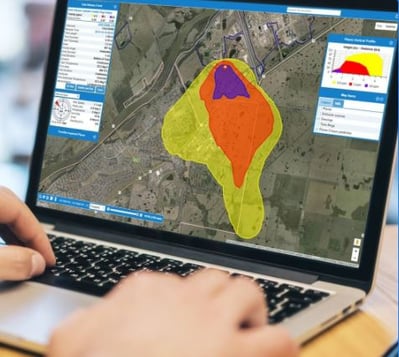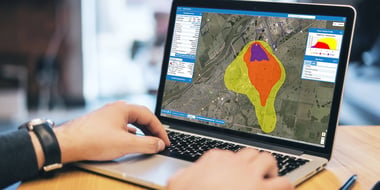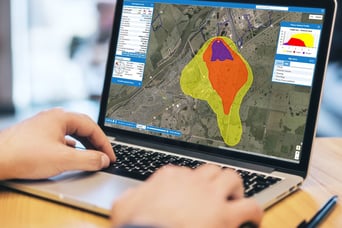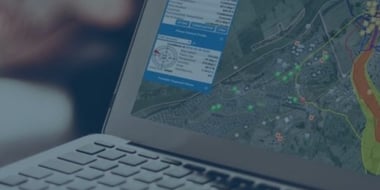Yes, you read that correctly—let me explain how. When I’m talking to industrial workers or safety managers in the field, they sometimes ask me why they should pay for dynamic plume modeling software when there are free apps that can model plumes, too. Most times, app-users must manually input information like weather conditions and the volume of the chemical spill, and the app does the calculations for them to create a plume.
You might be thinking: “Why would I pay for a service that I can access for free? I get everything I need already, for free.” Likely, you need to update wind changes, barometer shifts, and other factors every time you model a plume. Certainly that’s enough, right?
Nope! The plumes you can generate manually with your most recent information aren’t enough, and here’s why: the weather is constantly changing, with or without you changing it in the app.
Constantly Changing Conditions
If you’ve been deer hunting more than once, you know that when you’re on the ground you regularly watch for cues on where your scent is going. If a deer catches your scent, it will retreat and avoid that location for at least an hour or two and your hunt is probably ruined on the spot. That’s why it’s crucial to play the wind. One technique I use is squeezing a powder puffer around once an hour to make sure my scent isn’t carrying in the wrong direction.
.jpeg?width=1922&height=1022&name=deerhuntingcam%20(2).jpeg)
When you’re hunting on the ground, you’re in a relatively controlled environment because of the cover of trees and brush. Despite all the cover, you might notice that the wind will change and—literally—blow up your spot, changing the direction of your scent without much warning. As the day progresses and the weather changes, you might also shed layers of clothing, or put more layers on in some cases. I know hunters who even prepare for this by bringing a pack with all sorts of clothes so they can stay out in the woods longer more comfortably.
My point here is that the weather on the ground is slightly more controlled than in open areas, but even climbing up into a tree stand after being on the ground, you will probably notice a change in wind direction and perceived temperature. As the weather changes, (between rain and snow, sun and cloud cover, or wind speed or direction), and it changes a lot, your scent will go different directions at different rates and dispersions, as well.
Dynamic Plume Modeling with Automatic Live Updates
Now let’s switch back to plume modeling. If the weather is constantly changing, even throughout the course of a day, going from morning cold to afternoon warm, the plume direction and how it’s rising or travelling changes, too, just like your scent during a hunting trip. However, now you’re not worried about getting busted by a deer and wasting your day out, you’re worried about sending a toxic chemical like methyl ethyl over a playground or exposing your workers to toxic gases like sulfur dioxide over time. To me, that seems to be worth anyone’s attention.
Ignorance to this information might seem like bliss, but your workers, environment, and community depend on you to prevent and quickly resolve chemical releases or odor complaints. Without live weather data and live modeling, you may be preparing for or responding to the wrong situation due to outdated data. Like me in the woods, if you’re sitting upwind of the deer not knowing it, you’re wasting time and, in your case, precious resources/money. You can’t begin to address the incident if you don’t have a clear picture into what’s happening in the air.
 Here’s where dynamic plume modeling comes into play. With dynamic plume modeling software like SAFER One®, you can be confident that you always have a current and accurate window into the chemical hazards on your worksite. It’s like using your powder puffer in the woods to know you have the most updated wind direction before moving spots.
Here’s where dynamic plume modeling comes into play. With dynamic plume modeling software like SAFER One®, you can be confident that you always have a current and accurate window into the chemical hazards on your worksite. It’s like using your powder puffer in the woods to know you have the most updated wind direction before moving spots.
Software like this automatically pulls real-time data from on-site gas monitors, weather sensors, and local maps so when you start a shift by running models to see what risks your workers might encounter throughout the day or need to respond immediately to an emergency, you don’t have to worry about manually entering weather data. SAFER One can also pinpoint the source of a gas leak in three clicks with the Source Area Locator, enabling teams to stop emergencies quickly. Without real, live data, how can you confidently pinpoint the source?
After an emergency, dynamic plume modeling can also help safety teams understand the impact on the surrounding areas. For example, they can help you decide when it’s safe to re-open a site or tell people to come home to their community. But the impact doesn’t end there—you can review historical readings and run models based on past events to see the true impact a year later. And when compliance agencies come knocking, SAFER One streamlines your ability to recall data from past events and perform historical reporting by storing compliance records in one, easy-to-access digital archive.
If you’d like to learn more about how dynamic plume modeling can help you protect your people, plant, and community, download our eBook: How to Use Dynamic Plume Modeling for Safer Worksites and Communities or talk to one of our experts.
If you want to learn more about deer hunting, go read a book. Despite all this seemingly worthwhile knowledge of hunting, I’m terrible at it (because of the wind).



